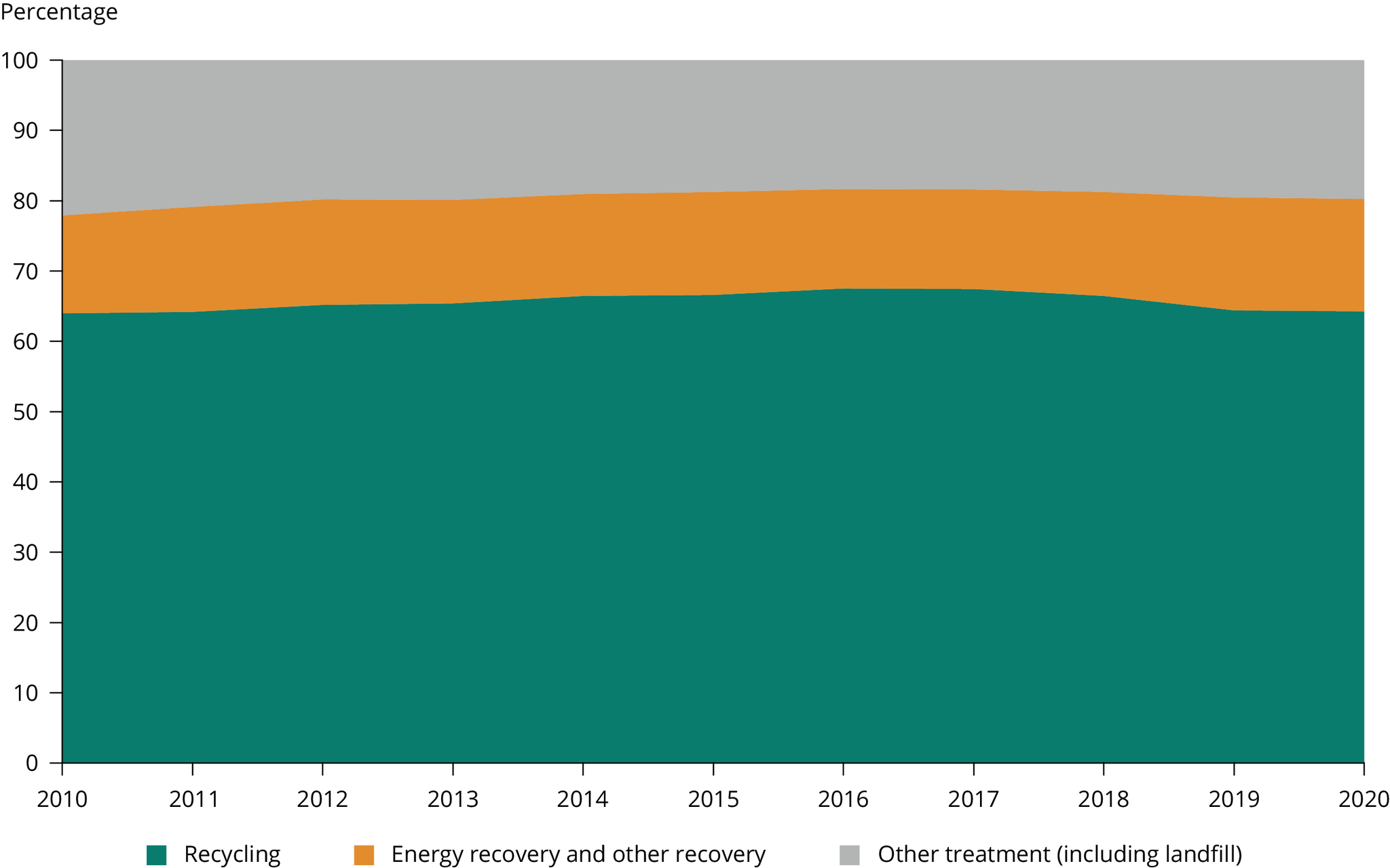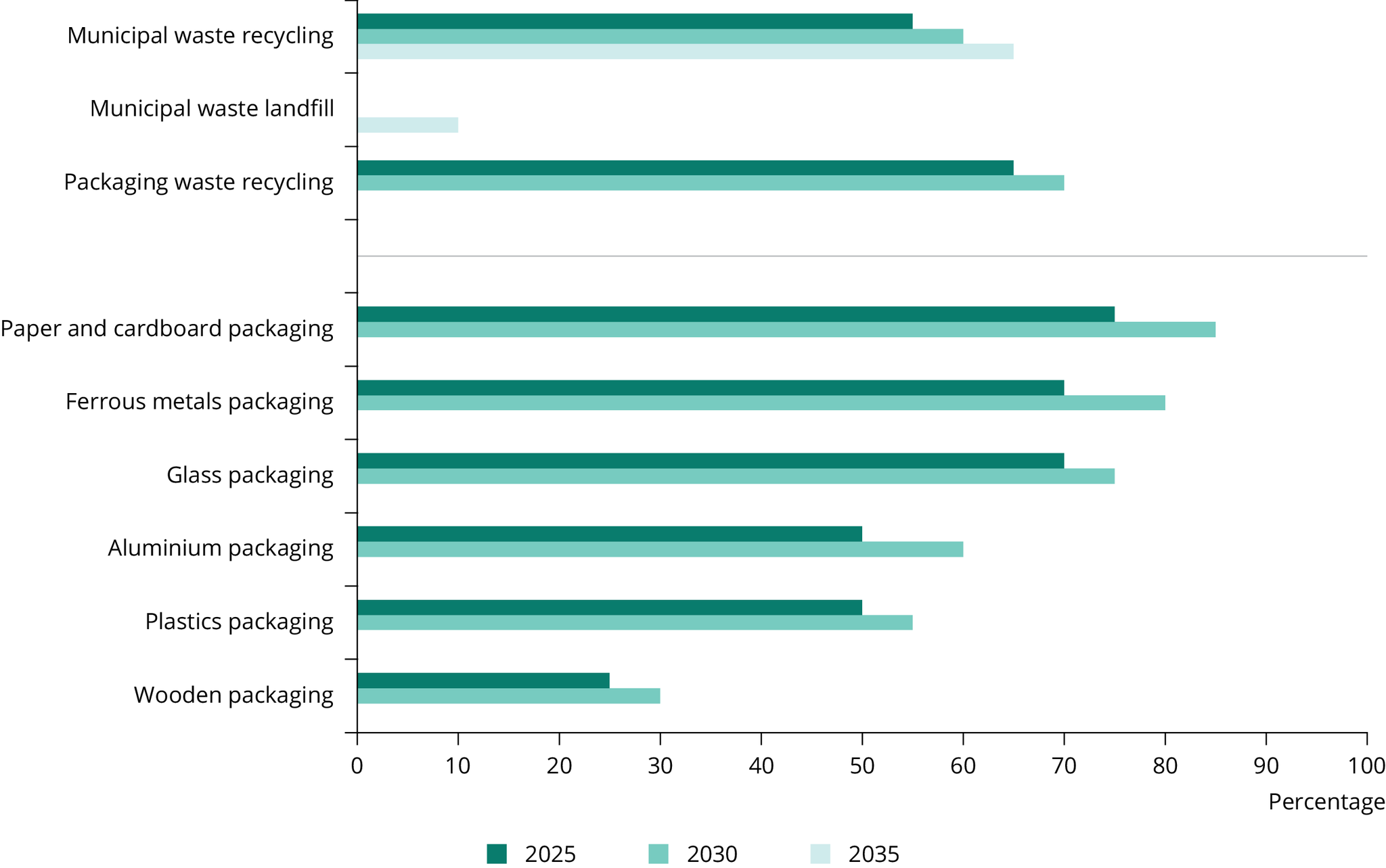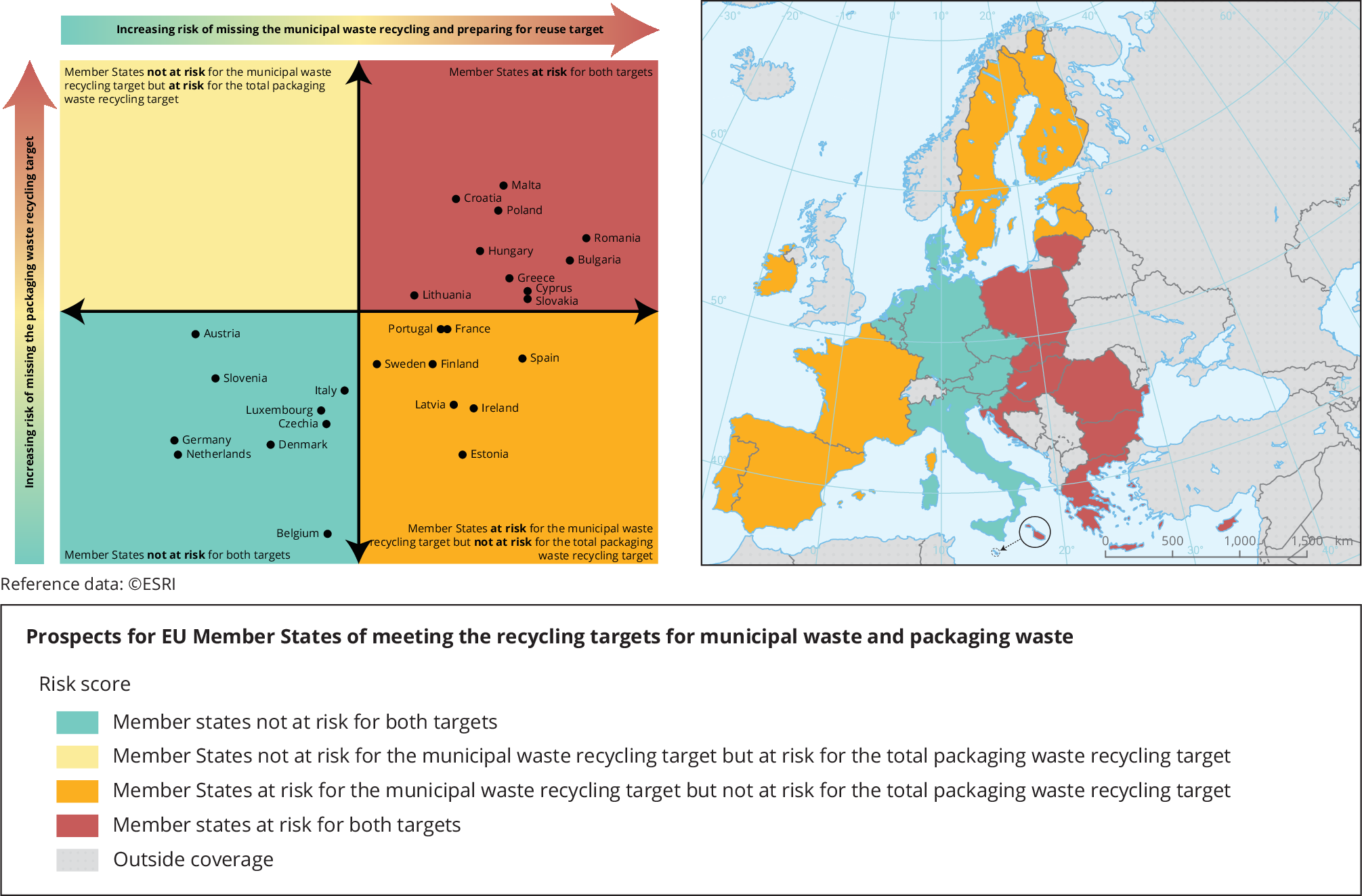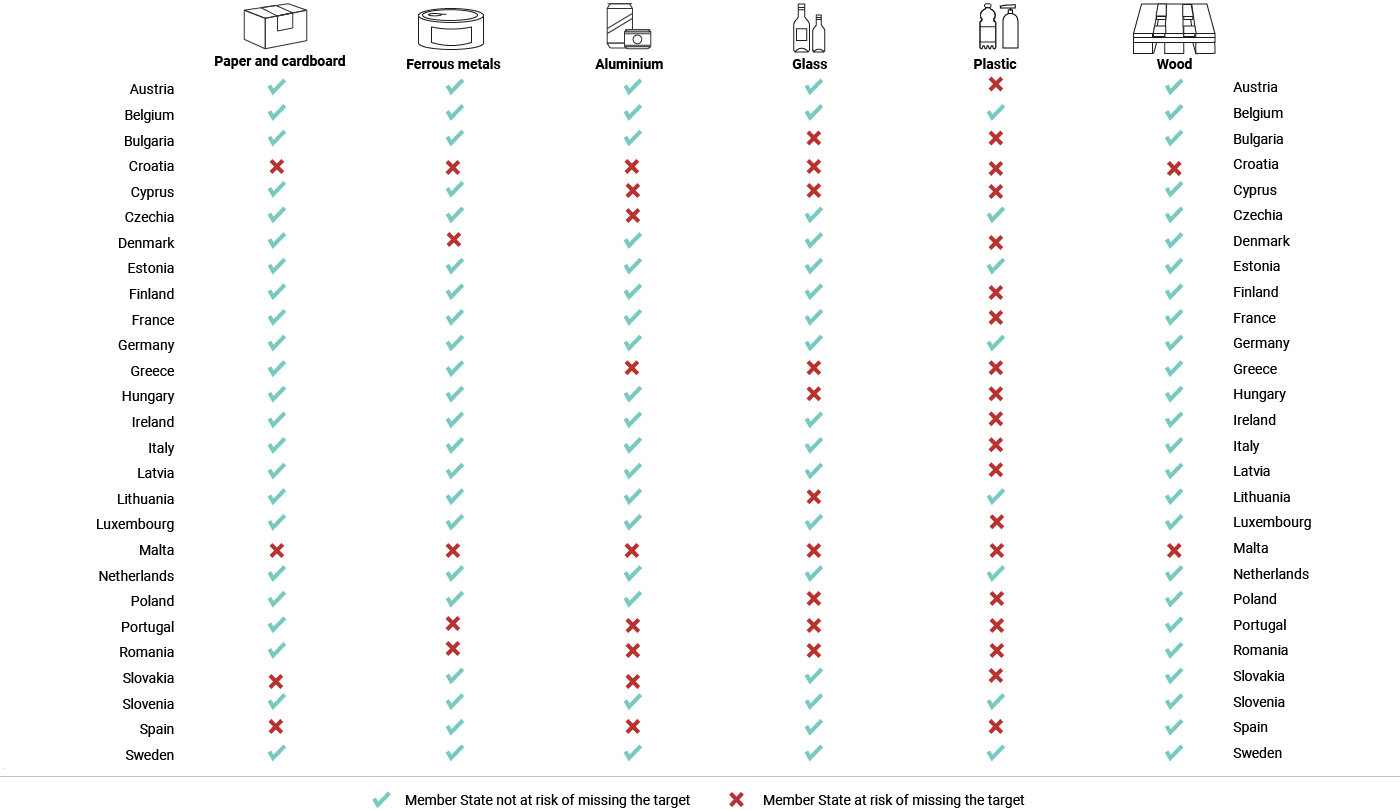Recycling — a key element of the circular economy
According to the European Green Deal, waste should be reduced. Where waste cannot be avoided, its economic value must be recovered and its impact on the environment and on climate change avoided or minimised. In line with these goals, the EU’s waste hierarchy gives highest priority to waste prevention, followed by preparing for re-use and recycling.
While the European Commission’s circular economy action plan includes a new commitment to develop waste reduction targets, existing EU waste legislation already sets binding, quantified targets for recycling several waste streams, including municipal and packaging waste. These apply to all EU Member States.
Moving towards higher recycling rates will secure much-needed material resources for Europe’s economy. This will help reduce greenhouse gas and other emissions that are generated when virgin resources are extracted and processed. It will also reduce dependencies and increase EU strategic autonomy for some key materials. Driven by EU and national policies, municipal waste management in the EU has slowly improved since 2010. However, progress in recycling rates has recently slowed down. Packaging waste recycling rates are higher than those for municipal waste but have barely changed over the same period. Most recently, the recycling rate for packaging waste may have actually slightly decreased, although changes in the reporting methodology countries use and the COVID-19 pandemic might be partly responsible for this (Figures 1 and 2).

Source: Eurostat (2022a).
Explore different chart formats and data here

Source: Eurostat (2022b).
Explore different chart formats and data here
EU targets for municipal waste and packaging waste
To further progress towards a circular economy, the Waste Framework Directive and the Packaging and Packaging Waste Directive set concrete targets for municipal waste and packaging waste management to be achieved by 2025, 2030 and 2035 (Figure 3). These targets are more ambitious compared to the previous recycling targets for municipal waste (to be met by 2020) and for packaging waste (to be met by 2008).
To realise the full environmental and resource-saving benefits, effective measures to ensure that the targets are met must be properly implemented in all EU Member States. Therefore, the directives introduced the ‘early warning’ mechanism to track progress towards the targets and inform Member States where additional efforts will be required.
Note: Targets for municipal waste refer to recycling and preparing for re-use. Targets for packaging waste refer to recycling.
Sources: EU Waste Framework Directive, 2008/98/EC; EU Packaging and Packaging Waste Directive, 94/62/EC; EU Landfill Directive, 1999/31/EC.
Explore different chart formats and data here
The early warning mechanism
The European Commission, in cooperation with the EEA, shall publish early warning reports three years ahead of the target years. The purpose of the early warning reports is to identify each Member State’s prospects of meeting the targets, as well as to anticipate barriers to implementation (Box 1). This will improve policy implementation and provide guidance on appropriate action that needs to be taken ahead of the target deadlines to achieve compliance. The first early warning report, with a focus on the 2020 recycling target for municipal waste, was published by the European Commission in 2018 (EC, 2018).
Box 1. Elements of the early warning reports
The three elements of the early warning reports are:
- an estimate of the attainment of the targets by each Member State;
- a list of the Member States at risk of not attaining the target(s) by the deadlines, accompanied by recommended remediating measures for the Member States concerned;
- examples of best practices that could drive progress towards attaining the targets.
Sources: EU Waste Framework Directive (Article 11b), EU Packaging and Packaging Waste Directive (Article 6b), EU Landfill Directive (Article 5b).
As a contribution to the European Commission’s early warning report for the target year 2025 (Box 2), the EEA developed early warning assessments (EEA, 2022) for all Member States in 2022. These indicate which Member States are likely to meet the targets and which Member States are at risk of not meeting them. The early warning assessments do not assess whether the Member States comply with the legal requirements of the directives.
Based on the findings of these assessments, the European Commission developed policy recommendations and best practices that are published as part of the formal early warning report to the European Parliament and the Council.
Box 2. Assessment methodology
The work was conducted by the EEA and supported by the European Topic Centre on Circular Economy and Resource Use. The assessments examined how Member States performed across a range of factors, including the current distance from the targets, the status of and planned improvement to the separate collection systems, and the use of economic instruments to support recycling. Scores were awarded under these categories and combined according to a weighting scheme to generate an overall score, expressed as a percentage, showing the risk that a Member State will miss its targets. In addition, the robustness of the underlying information for each of the factors was assessed[1].
The assessment methodology (ETC CE and EEA, 2022) was developed and tested by the EEA in close cooperation with a group of volunteering Member States and was further refined during its application. National authorities in the Member States were consulted on draft assessments; before being finalised, the assessments and the assessment process themselves were critically reviewed by external consultants.
Under certain conditions described in the directives, Member States can apply for derogations from the targets. However, this was not taken into account in the assessments as to do so would be premature.
The EEA’s early warning assessments are based on the data and information available up to March/April 2022. Meanwhile, more recent data have been published by Eurostat on both municipal waste and packaging waste. The early warning assessments therefore provide a snapshot of the risk in early 2022.
In addition to the recycling targets, the EU Landfill Directive requires the amount of municipal waste landfilled to be reduced to 10% of generated municipal waste by 2035. It envisages a similar early warning mechanism being implemented in 2032. A lighter approach to evaluating this target is included in the early warning profiles to give an initial indication of the barriers to meeting it.
EU Member States’ prospects of meeting the targets
The early warning assessments show that many Member States are not on track to meet the targets. 10 Member States may not meet both the 55% recycling target for municipal waste and the 65% recycling target for total packaging waste (Figure 4). Eight Member States are at risk of missing the recycling target for municipal waste but are on track to meet the packaging waste target for 2025.
Source: Early warning assessments related to the 2025 targets for municipal waste and packaging waste (EEA, 2022).
Explore different chart formats and data here
Results for the material-specific packaging waste targets vary considerably (Figure 5). The analysis shows that the targets for some packaging wastes, such as paper/cardboard and ferrous metals, are likely to be met by most Member States. This reflects well-established waste management practices in these countries coupled with the fact that these materials are reasonably homogeneous material streams. By contrast, the target for plastic packaging clearly poses challenges for a large number of Member States. This reflects the combined complexity of processing mixed plastic waste and having less mature infrastructure and markets for doing so.
Source: Early warning assessments related to the 2025 targets for municipal waste and packaging waste (EEA, 2022).
Finally, 13 Member States are at risk of missing the landfill reduction target of 10% by 2035 if efforts are not stepped up — Bulgaria, Croatia, Cyprus, Czechia, Greece, Hungary, Latvia, Malta, Poland, Portugal, Romania, Slovakia and Spain.
Conclusions
Out of the 18 Member States at risk of not meeting the 55% target for municipal waste preparing for re-use and recycling in 2025, 14 were already at risk of not meeting the previous target for 2020, as stated in the European Commission’s early warning report of 2018 (EC, 2018). This target, laid down in the Waste Framework Directive, required Member States to recycle and prepare for re-use at least 50% of specific types of household and similar waste. The 2025 target is not only more ambitious but also harder to meet because of tighter reporting rules.
Bio-waste is the largest single component of municipal waste. Separate collection of bio-waste for a large part of the population is therefore key in helping Member States reach their recycling target for municipal waste (EEA, 2023). In general, it was found that Member States at risk of not meeting their recycling target had neither convenient, separate collection in place for most of the population nor adequate, available treatment capacity. However, most of these Member States plan to improve the convenience and coverage of their bio-waste collection service in the coming years. Paying proper attention to how these plans are implemented will be key for meeting the targets.
The 50% recycling target for plastic packaging seems to be the most demanding of the material-specific packaging waste targets, with 19 Member States at risk of missing it. Plastic packaging is challenging to recycle. Its complex design often hinders recycling, contributing to high sorting losses during processing. The new calculation rules that will take these losses into account are therefore expected to negatively impact plastic packaging recycling rates. Progress in designing packaging for recycling will be crucial for achieving higher recycling rates. In addition, the assessments show that current collection systems often capture only a very limited share of plastics from municipal waste. This indicates considerable potential to improve the effectiveness of separate collection systems for plastics.
However, the assessments provide ample evidence that many Member States have implemented improved policies and measures for recycling municipal waste and packaging waste. These include the extension of separate collection systems; the development of new bio-waste treatment capacities; and the introduction of pay-as-you-throw schemes to incentivise sorting at source.
The EU’s early warning exercise demonstrates the critical value of monitoring in providing data to gauge the effectiveness of actions and indicate where policy implementation must be strengthened. Despite some positive developments, many Member States will have to intensify their future efforts to meet recycling targets.
Notes
[1] At the time the assessments were prepared, the data on the current levels of recycling available did not yet correspond to the calculation rules for showcasing target compliance. Therefore, how the new calculation rules influenced the data was only estimated in the assessments. Moreover, data on ferrous metals packaging and aluminium packaging had not yet been reported separately by 12 Member States at the time of writing the assessments. This leads to some uncertainties in assessing those countries’ prospects of meeting the targets for these two packaging materials.
References
EC, 2018, Report from the Commission to the European Parliament, the Council, the European Economic and Social Committee and the Committee of the Regions on the implementation of EU waste legislation, including the early warning report for Member States at risk of missing the 2020 preparation for re-use/recycling target on municipal waste, COM/2018/656 final.
EEA, 2022, Early warning assessments related to the 2025 targets for municipal waste and packaging waste, 27 country profiles, European Environment Agency, June 2022.
EEA, 2023, ‘Economic instruments and separate collection – key instruments to increase recycling’, European Environment Agency (https://www.eea.europa.eu/publications/instruments-supporting-recycling-in-europe/).
ETC CE and EEA, 2022, Methodology for the Early warning assessment related to certain waste targets (https://www.eionet.europa.eu/etcs/etc-ce/products/etc-ce-products/methodology-for-the-early-warning-assessment-related-to-certain-waste-targets) accessed 30 January 2023.
Eurostat, 2022a, ‘Municipal waste by waste management operations (env_wasmun)‘ (Statistics | Eurostat (europa.eu)), accessed 9 November 2022.
Eurostat, 2022b, ‘Packaging waste by waste management operations (env_waspac)‘, (Statistics | Eurostat (europa.eu)) accessed 9 November 2022.
Identifiers
Briefing no. 28/2022
Title: Many EU Member States not on track to meet recycling targets for municipal waste and packaging waste
EN HTML: TH-AM-22-028-EN-Q - ISBN: 978-92-9480-532-4 - ISSN: 2467-3196 - doi: 10.2800/988899
EN PDF: TH-AM-22-028-EN-N - ISBN: 978-92-9480-533-1 - ISSN: 2467-3196 - doi: 10.2800/403485





Document Actions
Share with others